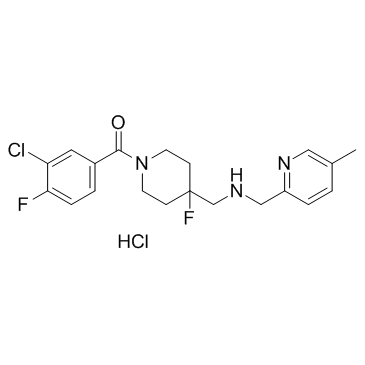Befiradol hydrochloride (NLX-112 (hydrochloride)) |
| Catalog No.GC34304 |
Products are for research use only. Not for human use. We do not sell to patients.

Sample solution is provided at 25 µL, 10mM.
Befiradol hydrochloride (NLX-112 hydrochloride) is a selective 5-HT1A receptor agonist.
Befiradol (F13640; NLX-112) reduces the activity of dorsal raphe serotonergic neurons at 0.2-18.2 μg/kg, i.v. (cumulative doses; ED50=0.69 μg/kg, i.v.) and increases the discharge rate of 80% of mPFC pyramidal neurons in the same dose range (ED50=0.62 μg/kg, i.v.). Both effects are reversed by the subsequent administration of the 5-HT1A receptor antagonist (±)WAY100635. In microdialysis studies, Befiradol (F13640; NLX-112) (0.04-0.63 mg/kg, i.p.) dose-dependently decreases extracellular 5-HT in the hippocampus and mPFC. Likewise, Befiradol (F13640; NLX-112) (0.01-2.5 mg/kg, i.p.) dose-dependently increases extracellular DA in mPFC, an effect dependent on the activation of postsynaptic 5-HT1A receptors in mPFC. Local perfusion of Befiradol in mPFC (1-1,000 μM) also increases extracellular DA in a concentration-dependent manner. Both the systemic and local effects of Befiradol are prevented by prior (±)WAY100635 administration[1].
[1]. Lladó-Pelfort L, et al. In vivo electrophysiological and neurochemical effects of the selective 5-HT1A receptor agonist, F13640, at pre- and postsynaptic 5-HT1A receptors in the rat. Psychopharmacology (Berl). 2012 May;221(2):261-72.
Average Rating: 5 (Based on Reviews and 37 reference(s) in Google Scholar.)
GLPBIO products are for RESEARCH USE ONLY. Please make sure your review or question is research based.
Required fields are marked with *




















